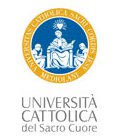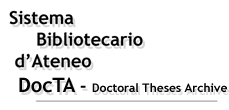|
|
DocTA - Doctoral Theses Archive >
Tesi di dottorato >
CORSO DI DOTTORATO IN SISTEMA AGRO-ALIMENTARE >
Citazione:
Utilizza queste indicazioni per citare o creare un link a questo documento.
|
Iula, Giusy. "The shared and specific effects of different abiotic and biotic elicitors on the secondary metabolism of tomato plants", Università Cattolica del Sacro Cuore, XXXIV ciclo, a.a. 2020/21, Piacenza, [http://hdl.handle.net/10280/115285].
|
| Titolo: | The shared and specific effects of different abiotic and biotic elicitors on the secondary metabolism of tomato plants |
| Autore/i: | IULA, GIUSY |
| Tutor: | TREVISAN, MARCO |
| Coordinatore: | AJMONE MARSAN, PAOLO |
| Lingua: | ENG |
| Abstract in italiano della tesi: | Il primo step del progetto di ricerca si è incentrato sulla coltivazione delle piantine di pomodoro (Solanum lycopersicum L.). le piantine sono state fatte crescere in un ambiente controllato per poter mantenere delle condizioni standard ed evitare di sottoporre a stress abiotici. Al raggiungimento della quarta foglia vera le piante sono state trattate con diversi agenti stressogeni. Come prevedeva il progetto di ricerca i trattamenti si sono incentrati su:
- crescita in assenza totale di azoto;
- crescita in azoto 20 Mm;
- crescita in azoto 30 Mm;
- trattamento con chitosano 10 gel in acido acetico;
- trattamento con 1 m acido acetico (controllo negativo per il chitosano);
- trattamento con fitosanitario a base di traizolici e strobilurine, quilt xcell (Syngenta) a base di azoxystrobin 141.4 g/l+ propioconazole 122.4 g/l;
- trattamento con fitosanitario a base di triazolici, opinion ecna (Adama) propioconazolo 250 g/l;
- trattamento con acido salicilico 0.01 mm;
- trattamento con poliamine 0.1 mm;
- trattamento con benzothiadiazole 137 mg/l;
- trattamento con Trichoderma;
- trattamento con Microrizza;
- non trattato, il controllo negativo per le analisi.
A seguito dei trattamenti le piante sono state sottoposte ad harvest dopo 5 giorni. Il campionamento si è basato su peso fresco e secco delle piante, raccolta di 3-5 foglie per palco. I campioni sono stati così stoccati a -18°c.
Le foglie sono state poi triturate con azoto liquido di modo da mantenere intatti i metaboliti secondari presenti. Lo step successivo vede l’estrazione dei metaboliti con un protocollo di estrazione con metanolo 80%+ acido formico 1%, omogenizzazione con ultraturex, centrifugazione, filtrazione e stoccaggio a -18°C.
I campioni sono stati elaborati con un untarget LC-MS/MS. L’analisi statistica dei dati raccolti è stata realizzata basandosi su HCA (hierarchical combined tree on treatment), PCA, OPLS-DA, volcano analysis e l’utilizzo combinato del database plant metabolic network, keeg pathway.
Dall’analisi dei dati è emerso che, i trattamenti in presenza di un eccesso di azoto hanno portato ad una upregolazione degli alkaloids di difesa, anotcianine, flavonoidi e fitoalexine. Mentre, le piante cresciute in carenza di azoto hanno dimostrato una attivazione differenziale degli stessi pathway e maggiori condizioni di stress.
Per quanto riguarda le piante di pomodoro incubate con Trichoderma hanno evidenziato una upregolazione dei pathway coinvolti nella detossificazione di composti tossici per la pianta, up regolazione anche nella produzione degli alkaloidi di difesa, della famiglia delle antocianine e fitoalexine. Una up regolazione è stata anche evidenziata nella produzione di fitosteroli. Mentre, le piante incubate con mychorrhiza non evidenziano una attivazione dei pahtway di detossificazione cellulare ma, una up regolazione nella produzione di isoflavonodi e antocianine nella forma glucosilata.
Mentre, le piante trattate con controllo positivo, chitosano, una mixture di poliamine o acido sialicidico hanno mostrato come non vi sia una risposta diretta volta ad aumentarne la biomassa. Invece, ad essere aumentata in tutte le tesi è la produzione di metaboliti della classe dei pheylpropanoids ed il profilo lipidico. Tutti i cambiamenti sembrano indirizzare la pianta verso una più efficiente risposta allo stress. In ultimo, le piante sottoposte all’azione dei pesticidi hanno mostrato una diminuzione della crescita combinata con un aumento dell’attività dei processi di detossificazione ed anche in questo caso è stata riscontrata una maggiore presenza dei compositi della classe dei phenylpropanoids coinvolti in processi di difesa.
In conclusione, tutti i trattamenti si sono dimostrati efficienti nell’indurre cambiamenti metabolici tali da aumentare la resistenza delle piante a condizioni avverse. |
| Abstract in inglese: | Plants are sessile organisms and therefore, they are subject to different sources of abiotic and biotic stresses. Example of abiotic stresses includes radiation, salinity, floods, drought, extremes in temperature and heavy metals. Unlike vertebrates, plants lack mobile immune cells and an adaptive immune system therefore, they have evolved different strategies to perceive and respond to the stress. Unlike vertebrates, plants lack mobile immune cells and an adaptive immune system therefore, they have evolved different strategies to perceive and respond to the stress.
The first layer of plant defense systems are physical barriers, the cuticle and the cell wall, that deny access to a wide range of microbes but, also reduce water loss and protect against UV radiation. In addition to these non- specific defense mechanisms, plants have evolved a sophisticated immune response activated by the perception of highly conserved molecular features of different classes of bacterial and fungal pathogens, referred to as microbe/pathogen- associated molecular patters (M/PAMPS). This results in the activation of a defense response referred to as M/PAMPS- trigged immunity (M/PTI). Despite the activation of this line of defense, some pathogens have evolved strategies to suppress M/PTI. To overcome this infection strategy, plant have evolved specialized immune receptors encoded by resistance (r) genes (R proteins) that recognize these pathogen- specific effectors, thereby leading to an amplified secondary immune response known as effector- trigged immunity (ETI). ETI is characterized by the induction of localized programmed cell death (PCD) (referred to as the hypersensitive response or HR) in order to limit the spread of the infection, activation of defence gene expression and, induction of systemic acquired resistance (SAR) to conferring broad spectrum resistance in plants. SAR increases plant defence not only at point of infection but from whole plant. The systemic plant resistance can also be mediated by beneficial microbes living in the rhizosphere, like bacteria and fungi, this kind of plant resistance is known as induced systemic resistance (ISR). ISR is associated with enhanced ability, the so- called “priming”, to resist to stress conditions.
Pricing is a mechanism that does not involve a direct activation of plant defense machinery but, it is an improved of perception and/ or amplification of defense. Priming is an adaptive, low- cost defensive measure because defense responses are only, slightly and transiently, activated by a given priming stimulus. Following the perceptions of a second stress signal (triggering stimulus), defense responses are deployed in a faster, stronger, and/or more sustained manner. Priming can involve various layers of induced defense mechanisms that are active during different levels of plant- pathogen interactions. To better understand the intracellular pathways activated upon the priming phase, molecular studies of priming strategy have been performed. These studies have recorded chromatin changes and the accumulation of mRNA of genes with a signaling role in defense, of signaling proteins and plant recognition receptors (PRRS), metabolites, and other molecular components supporting a faster, stronger, and more sustained response to a triggering stress. However, the complete elucidation of molecular pathways activated upon the perception of primed stimulus is not truly clear therefore, further studies are required.
The goal of this work is to investigate on molecular mechanism of priming in the induction of ISR in plants. Metabolomics is a new field of studies that able to detect and measure all the small- molecules, metabolites, present in a given moment into a biological system. Therefore, metabolomics can be the molecular tool to detect all the changes that occur in the plant cells upon the exposure to the pricing agent and it is the perfect tool to link the metabolic change in the cell to the phenotype. To this purpose, tomato (Solanum lycopersicum L.) has been selected as model plant due to its economic interest and because of its diverse secondary metabolism. Tomato plants were grown devoid of chemical or microbiological treatments until growth stage of 9 or more leaves on main shoot unfolded and treated with different priming elicitors:
Muscular mycorrhizal fungi (AMF), Trichoderma spp., benzothiadizole as positive control, triazole fungicide, a combination of strobiulurin and triazole fungicide, chitosan molecule and acetic acid (since the chitosan compound is soluble in acid medium therefore, an additional control is required), salicylic acid, polyamine mixture and in presence on nitrogen deficiency and nitrogen surplus. For plants grown under nitrogen deficiency and nitrogen surplus a different grown medium was required to avoid interference, these plants were grown in coconut coir.
Tomato plants were harvested after 15 days treatments with chemical compounds and Trichoderma spp. And after 30 days for AMF inoculation. For plants grown under nitrogen deficiency/ surplus the harvest was made at growth stage of first flower bud visible. After biomass of leaves was determined together with extraction of metabolites for UHPLC/qTOF-MS analysis to investigate on molecular pathways.
The study demonstrated as plants inoculated with either Arbuscular mycorrhizal fungi (AMF) or Trichoderma spp. Showed a positive effect on plant growth increasing their biomass index. The same beneficial effect on plant growth was observed in plants grown with a nitrogen surplus. While, the biomass index was not increased when plants were treated with benzothiadizole, chitosan, polyamines, salicylic acid or two pesticides, one containing only triazole and second one containing a combination of triazole and strobilurin.
Notwithstanding, a broad molecular cell re-programming was also observed to include some common responses between thesis. In particular, the phenylpropanoid biosynthetic pathway was strongly elicited, with the production of defense phenolics like coumarins, bis-noryangonin, anthocyanins, and their glycosylated form in tomato under biotic stress. While, under abiotic stress (benzothiadizole, nitrogen deficiency, nitrogen surplus, chitosan, polyamines, salicylic acid, triazole compounds and a combination of triazole and strobilurin) there was an over expression of quercetin, terpenoid, amide derivate and, also anthocyanins.
Another important aspect was the remodeling of membrane lipids and the production of sphingolipids as signal molecules. Under abiotic stress the sterol/phospholipid ratio increased with increasing of membrane rigidity, changes in membrane permeability and activation of stress response to abiotic factors. While, in presence of nutritional alteration (both in deficiency and surplus) the membrane composition changed decreasing the sterol to phospholipid ratio increasing in membrane fluidity probably in one case to boost nutrient uptake and in second one to avoid an intoxication due to a high amount of nitrogen in the cell.
At same time, the shaping of phytohormone profiles resulted in the accumulation of auxins, cytokinins, and jasmonate under biotic stress. While, under abiotic stress there was an increasing in gibberellin and cytokinins to boost pant defenses. The treatments with pesticides lead to an increasing in brassinosteroids involved in detoxification pathways.
To conclude, the establishment of symbiosis between plant and AMF and Trichoderma impacted several plant secondary metabolism processes in a fashion that supports both plant growth promotion and immunity. While the stress induced by abiotic factors were demonstrated to active similar cellular re- programming. Even if treatments do not increase plant growth, they were efficiently to increase plant survival to future stresses. |
| Digital Object Identifier (DOI): | https://doi.org/10.3390/plants11050678
https://doi.org/10.3390/horticulturae7100394 |
| Data di discussione: | 23-mar-2022 |
| URI: | http://hdl.handle.net/10280/115285 |
| È visualizzato nelle collezioni: | CORSO DI DOTTORATO IN SISTEMA AGRO-ALIMENTARE
|
File in questo documento:
| File |
Descrizione |
Dimensioni | Formato | Accessibilità |
|---|
| Thesis PhD_Giusy Iula_Agrisytem_18.02.22.pdf | The shared and specific effects of different abiotic and biotic elicitors on the secondary metabolism of tomato plants_Tesi PhD Iula G. | 6,9 MB | Adobe PDF | non consultabile
|
|
Accesso e utilizzo dei contenuti di DocTA
|



